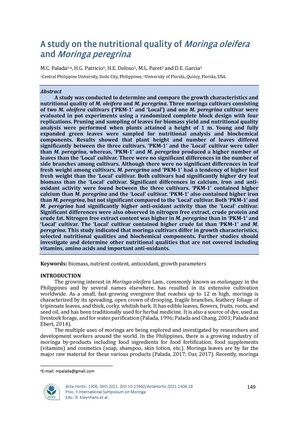The moringa industry in the Philippines: Status, challenges and opportunities
| dc.contributor.author | Palada, Manuel C. | |
| dc.date.accessioned | 2022-07-05T01:43:54Z | |
| dc.date.available | 2022-07-05T01:43:54Z | |
| dc.date.issued | 2017-05-09 | |
| dc.identifier.citation | Palada, M. C. (2017). The moringa industry in the Philippines: Status, challenges and opportunities. In Ebert, A. W. and Palada, M.C. (Eds.), I International Symposium on Moringa (pp. 447-453). International Society for Horticultural Science. https://doi.org/10.17660/ActaHortic.2017.1158.52 | en_US |
| dc.identifier.isbn | 978-94-62611-55-9 | |
| dc.identifier.issn | 0567-7572 | |
| dc.identifier.uri | https://hdl.handle.net/20.500.12852/2131 | |
| dc.description | Conference paper | en_US |
| dc.description.abstract | Moringa is one of the world's most useful trees and in the Philippines almost all parts of the plant are used for food and traditional medicine. Various research and development efforts are currently focused on food fortification to utilize the nutritional value of moringa and its medicinal potentials. For the past 10 years the moringa industry in the Philippines has grown significantly as research and development efforts have focused on this crop. Moringa leaves and seed oil are the major raw materials used in the food and nutrition industry, in cosmetics and herbal medicine. The leaf powder is mainly used for food fortification as ingredient of bread, noodles, juices, milk and tea, while the leaf powder capsule is mostly used as food supplement and herbal medicine. Moringa oil is predominantly used in cosmetics and personal health care products such as shampoo, soap, perfumes and skin care. More new moringa-based products are being developed by more than 20 food and cosmetic industries in the Philippines. In spite of the growing moringa industry there is a shortage of good quality fresh and dry moringa raw materials. The supply of moringa powder is inadequate and unstable and can be attributed to a scarcity of seed and planting materials. There is no stable and commercial moringa oil industry due to limited seed supply. The moringa industry in the Philippines is slowly being developed with the assistance of the government and private sectors. The next step is to develop a national program for the industry. There are gaps that need to be addressed. Establishing good agricultural practices and stringent regulations to guarantee the quality and stability of moringa products is top priority. Addressing the great demand for planting materials is another major challenge. The opportunities of moringa-based products seem bright and key players are aiming to penetrate the international market. | en_US |
| dc.language.iso | en | en_US |
| dc.publisher | International Society for Horticultural Science | en_US |
| dc.relation.ispartofseries | ISHS Acta Horticulturae;1158 | |
| dc.subject.lcsh | Moringa oleifera | en_US |
| dc.subject.lcsh | Food industry and trade | en_US |
| dc.subject.lcsh | Herbs--Therapeutic use | en_US |
| dc.subject.lcsh | Moringa | en_US |
| dc.subject.lcsh | Moringa--Therapeutic use | en_US |
| dc.subject.lcsh | Medicinal plants | en_US |
| dc.subject.lcsh | Plant products industry | en_US |
| dc.subject.lcsh | Plant products | en_US |
| dc.subject.lcsh | Philippines | en_US |
| dc.title | The moringa industry in the Philippines: Status, challenges and opportunities | en_US |
| dc.type | Conference paper | en_US |
| dcterms.accessRights | Limited public access | en_US |
| dc.citation.firstpage | 447 | en_US |
| dc.citation.lastpage | 453 | en_US |
| local.subject | Moringa products | en_US |
| local.subject | Food fortification | en_US |
| local.subject | Herbal medicine | en_US |
| local.subject | Food industry | en_US |
| local.subject.scientificname | Moringa | en_US |
| local.subject.scientificname | Moringa oleifera | en_US |
| dc.identifier.doi | 10.17660/ActaHortic.2017.1158.52 | |
| dc.citation.conferencetitle | I International Symposium on Moringa | en_US |
| dc.identifier.essn | 2406-6168 |
이 항목의 파일
| 파일 | 크기 | 체재 | 전망 |
|---|---|---|---|
|
이 항목과 관련된 파일이 없습니다. |
|||




